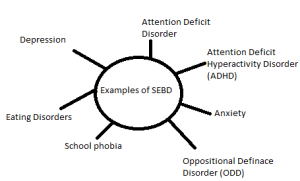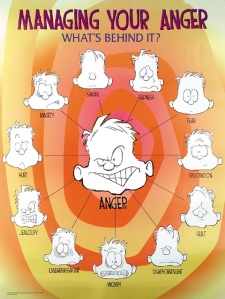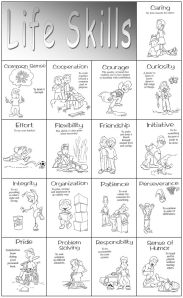SEBD is an umbrella term which is used to describe a range of social, emotional and behavioural difficulties experienced by many children and young people in today’s society.

Background:
- There are many various definitions for SEBD, however, there is no absolute definition (Howarth and Fisher, 2005). This highlights the complexities of SEBD for the individual themselves, their family and the practitioners. Despite the lack of a clear definition, SEBD are classified as both a special educational need and as a disability.
- Disability Discrimination Act (1995): Individuals who have a mental impairment which has a significant and adverse long term impact upon the individual are categorised as having a disability. To access the whole act click here
- SEN code of practice (2002): Individuals who demonstrate social, emotional and behavioural difficulties such as disruptive/disturbing behaviours, concentration issues, hyperactivity and various others do have a special educational need. Click here to access the whole document.
- As highlighted earlier there is not a definite definition of SEBD. It is therefore more crucial than ever for teachers to develop strategies for inclusive practice which will help to make learning more accessible. This page is going to highlight strategies that you as a teacher could implement which will help to promote effective inclusive practice.
The diagram above highlights a variety of examples of SEBD experienced by children.
The YouTube video above is a BBC Horizon documentary highlighting what it is like to live with ADHD. This documentary may be helpful to teachers who want to gain a greater understanding around the impact of ADHD on day-to-day life.
Strategies:
Due to the nature of SEBD being used as an umbrella term this section is going to identify useful and effective strategies that your school and you as a outstanding teacher could use to support children with a variety of needs. Schools can adopt a variety of strategies which can help to promote inclusion. However, it cannot be forgotten that these strategies may be beneficial in the home also.
Individual approaches:
Before an effective strategy can be implemented it is important for the teacher to gain an understanding around why these behaviours are being shown. The Challenging Behaviour Foundation (2013) strongly support the previous statement by highlighting that behaviour is not just sporadic and it does happen for a reason. Therefore, identifying and being aware of the underlying cause is key to effective behaviour management. This could be specifically true for children with SEBD.
- The A B C model: This model strongly supports the previous ideas in relation to determining the underlying cause for behaviour. The model focuses on looking at the
 context of behaviour (Antecedent), the Behaviour itself and what generally happens after (Consequence). This model could help you gain a greater understanding around why a pupil is displaying certain behaviours. Therefore, resulting in the teacher being able to remove/reduce trigger factors and implement strategies that will help support the pupil. The TDA developing people, improving young lives created a document for newly qualified teachers (NQT), focusing on removing barriers for children with SEBD. Click here to access the document. This will help to support and develop effective inclusive practice. Within this document is a useful guide as to how to use the ABC model. It could be argued that this model is more focused on addressing the issues than just ‘changing’ or ‘fixing’ the undesired behaviours exhibited by some children. Therefore, supporting and promoting effective inclusive practice.
context of behaviour (Antecedent), the Behaviour itself and what generally happens after (Consequence). This model could help you gain a greater understanding around why a pupil is displaying certain behaviours. Therefore, resulting in the teacher being able to remove/reduce trigger factors and implement strategies that will help support the pupil. The TDA developing people, improving young lives created a document for newly qualified teachers (NQT), focusing on removing barriers for children with SEBD. Click here to access the document. This will help to support and develop effective inclusive practice. Within this document is a useful guide as to how to use the ABC model. It could be argued that this model is more focused on addressing the issues than just ‘changing’ or ‘fixing’ the undesired behaviours exhibited by some children. Therefore, supporting and promoting effective inclusive practice.
Whole school approaches:
Social and Emotional Aspects of Learning (SEAL) was first introduced under the previous Labour government in 2005. SEAL had a very prominent status in primary schools. The Department for Education and Skills (2005) expressed that SEAL can be used throughout the whole-curriculum and strongly helps develop children’s social, emotional and behavioural skills. The skills promoted through SEAL such as self-awareness, managing feelings, motivation, empathy and social skills are all linked to promoting positive behaviour (Aggleton, 2005).
Despite the change in government SEAL is still used as an effective strategy to help support and develop children’s social, emotional and behavioural skills. Therefore, strongly supporting pupil’s with SEBD. If you want to find out more information you can access a very helpful information pack about SEAL by clicking here. This is a good resource for teachers as it identifies the process of SEAL. The publications direct aim is to promote the development and achievement of all learners. This strongly supports inclusive practice.
How is it implemented in schools to support children with SEBD?
Aggleton (2005) identifies that SEAL can be used through different waves. The first ‘wave’ focuses on whole-school approaches as discussion earlier. However, the second ‘wave’ of SEAL focuses more on small group or individual work and outreach work with parents. It is clear how SEAL could be used to work with children with SEBD in regards to promoting positive behaviours through the different waves.
Classroom displays that promote SEAL:
Here are a number of pictures of different ways to use SEAL in a classroom.
Photo’s courtesy of http://www.creative-corner.co.uk/schools/mec/BIP/SEAL.shtml
Does SEAL develop children’s well-being?
It could be suggested that SEAL helps to develop children’s well-being and help to build up their resilience to certain issues. The importance of developing children’s well-being and resilience has been identified by this group and a recent blog post has been published which may be of interest to you. Click here for blog post.
Pinterest: Pinterest is a content sharing website which allows members to ‘pin’ images to their own pinboard. There is a Pinterest site dedicated to SEAL. On this site you can find useful images to help you in the classroom. Below are two images that can be found on the site. Click here to be directed to the site.
Parent-Teacher relationship and parental engagement 
Building positive relationships between the families of the children you teach and facilitating their engagement in their child’s education is essential to effective practice. As outlined in the Teacher’s Standards (TS), teachers are required to communicate effectively with parents with regards to pupils’ achievement and well-being (TS8). To access the document click here. It has been identified that children’s behaviour can be improved if effective relationships are built between the school and the family. This highlights another strategy schools can implement to support children with SEBD.
It could be suggested that one way of communicating effectively with parents’ and guardians is to fully engage them with their children’s learning and development and also by holding parent/guardian training sessions in your school . The National Foundation for Educational Research (2013) published a teachers’ guide which investigated and reviewed the ways that schools and teachers can implement strategies to help narrow the gap in attainment. It has been highlighted that engaging families through the use of training and support can increase their confidence with behaviour management and therefore support and promote children’s development. It could be suggested that providing these in your school may help support children with SEBD, especially with creating positive behaviours.
The National Institute for Health and Clinical Excellence (2007) have created a parent-training/education document for the management of children with conduct disorders. This may be of interest to you as it may help to identify strategies that you may wish to involve the parents of child who has a conduct disorder in your classroom or school.
Conclusion:
I hope that you can see from this resource page that it is possible to provide effective inclusive practice for children with SEBD in an education setting. As highlighted earlier, SEBD are complex and each case is going to be different. This resource page has analysed and evaluated a variety of strategies that you may want to research further and adopt into your classroom dependant on the pupil’s needs. I hope the links provided offer further reading and help you to gain a greater understanding of how to implement effective inclusive practice strategies into your classroom and whole-school. In order for all children to succeed I strongly believe in finding the most effective strategy suited to the individual. I hope that the strategies provided in this resource page will be of use to you now or in the future! The related articles section underneath has articles that may help to develop your thinking, understanding and pedagogical knowledge around SEBD.
Related articles
- How do you manage your child’s behaviour? (mylittlesunshinehouse.com)
- Teaching and Learning (beechhill.wordpress.com)
- Understanding and Supporting Students with Social, Emotional and Behavioural Difficulties: A Practical Guide for Staff and Students.
References:
About Challenging Behaviour: What do we mean by ‘challenging’ behaviour? (2013). Retrieve November 6, 2013 from the Challenging Behaviour Foundation website: http://www.challengingbehaviour.org.uk/about-cbf/about-challenging-behaviour.html
Aggleton, P, Dennison, C, Warwick, I (2010). Promoting Health and Well-being through Schools. Routledge: Oxon.
Aston, H. and Grayson, H. (2013). Teacher Guide: Rapid Review of Parental
Engagement and Narrowing the Gap in Attainment for Disadvantaged Children. Slough
and Oxford: NFER and Oxford University Press
Department for Education and Skills (2005). Excellence and Enjoyment: Social and Emotional Aspects of Learning, guidance. Cm, 1378. London.
Department for Education and Skills (2001). Special Educational Needs: Code of Practice, Cm 581. London: Stationary Office.
Great Britain. Department for Education. (2012). Teacher’s Standards. London: HMSO.
Howarth, R, Fisher, P. (2005) Emotional and Behavioural Difficulties [electronic version]. Continuum.
Living with ADHD BBC documentary (2013). Retrieved November 10, 2013, from YouTube: http://www.youtube.com/watch?v=5lrcxmOolB8
Parent-training/education programmes in the management of children with conduct disorders (2007). Retrieved November 15, 2013, from the National Institute for Health and Clinical Excellence website: http://www.nice.org.uk/nicemedia/pdf/ta102guidance.pdf
Social and Emotional Aspects of Learning (N.D). Retrieved November 22, 2013, from the Creative-Corner website: http://www.creative-corner.co.uk/schools/mec/BIP/SEAL.shtml
Social and Emotional Aspects of Learning (N.D). Retrieved November 6, 2013, from the Pinterest website: http://www.pinterest.com/hfunne1/social-emotional-aspects-of-learning/
Training and Development Agency for Schools (N.D). Materials for newly qualified teachers. Removing barriers: behavioural, emotional and social difficulties (BESD), Manchester: TDA.
Session 3 – Safeguarding and Wellbeing (2013). Retrieved November, 23, 2013, from WordPress: https://sie55.wordpress.com/





